Sensory Profile of Semi-Hard Goat Cheese Preserved in Oil for Different Lengths of Time
Abstract
1. Introduction
2. Materials and Methods
2.1. Semi-Hard Goat Cheese Production
2.2. Cheese Sampling
2.3. Quantitative Descriptive Analysis (QDA)
2.4. Texture Analysis
2.5. Data Analysis
3. Results and Discussion
Sensory Properties of Air- and Oil-Ripened Semi-Hard Goat Cheese
4. Conclusions
Author Contributions
Funding
Institutional Review Board Statement
Informed Consent Statement
Data Availability Statement
Conflicts of Interest
References
- RedCorn, R.; Fatemi, S.; Engelberth, A.S. Comparing End-Use Potential for Industrial Food-Waste Sources. Engineering 2018, 4, 371–380. [Google Scholar] [CrossRef]
- Lin, C.S.K.; Pfaltzgraff, L.A.; Herrero-Davila, L.; Mubofu, E.B.; Abderrahim, S.; Clark, J.H.; Koutinas, A.A.; Kopsahelis, N.; Stamatelatou, K.; Dickson, F.; et al. Food Waste as a Valuable Resource for the Production of Chemicals, Materials and Fuels. Current Situation and Global Perspective. Energy Environ. Sci. 2013, 6, 426–464. [Google Scholar] [CrossRef]
- Lin, C.S.K.; Koutinas, A.A.; Stamatelatou, K.; Mubofu, E.B.; Matharu, A.S.; Kopsahelis, N.; Pfaltzgraff, L.A.; Clark, J.H.; Papanikolaou, S.; Kwan, T.H.; et al. Current and Future Trends in Food Waste Valorization for the Production of Chemicals, Materials and Fuels: A Global Perspective. Biofuel Bioprod. Biorefining 2014, 8, 686–715. [Google Scholar] [CrossRef]
- Hammond, S.T.; Brown, J.H.; Burger, J.R.; Flanagan, T.P.; Fristoe, T.S.; Mercado-Silva, N.; Nekola, J.C.; Okie, J.G. Food Spoilage, Storage, and Transport: Implications for a Sustainable Future. Bioscience 2015, 65, 758–768. [Google Scholar] [CrossRef]
- Kaczyński, Ł.K.; Cais-Sokolińska, D.; Bielska, P.; Teichert, J.; Biegalski, J.; Yiğit, A.; Chudy, S. The Influence of the Texture and Color of Goat’s Salad Cheese on the Emotional Reactions of Consumers Compared to Cow’s Milk Cheese and Feta Cheese. Eur. Food Res. Technol. 2023, 249, 1257–1272. [Google Scholar] [CrossRef]
- Kabaran, S. Olive Oil: Antioxidant Compounds and Their Potential Effects over Health. In Functional Foods; Lagouri, V., Ed.; IntechOpen: London, UK, 2019; pp. 1–19. [Google Scholar]
- Klisović, D.; Koprivnjak, O.; Novoselić, A.; Pleadin, J.; Lešić, T.; Brkić Bubola, K. Compositional Changes in the Extra Virgin Olive Oil Used as a Medium for Cheese Preservation. Foods 2022, 11, 2329. [Google Scholar] [CrossRef]
- Tudor Kalit, M.; Kalit, S.; Delaš, I.; Kelava, N.; Karolyi, D.; Kaić, D.; Vrdoljak, M.; Havranek, J. Changes in the Composition and Sensory Properties of Croatian Cheese in a Lamb Skin Sack (Sir Iz Mišine) during Ripening. Int. J. Dairy Technol. 2014, 67, 255–264. [Google Scholar] [CrossRef]
- Miller, B.A.; Lu, C.D. Special Issue—Current Status of Global Dairy Goat Production: An Overview. Asian-Australas J. Anim. Sci. 2019, 32, 1219–1232. [Google Scholar] [CrossRef]
- Kalit, S.; Lukac Havranek, J.; Kaps, M.; Perko, B.; Cubric Curik, V. Proteolysis and the Optimal Ripening Time of Tounj Cheese. Int. Dairy J. 2005, 15, 619–624. [Google Scholar] [CrossRef]
- De Almeida, A.M.; Alvarenga, P.; Fangueiro, D. The Dairy Sector in the Azores Islands: Possibilities and Main Constraints towards Increased Added Value. Trop. Anim. Health Prod. 2021, 53, 40. [Google Scholar] [CrossRef] [PubMed]
- Nájera, A.I.; Nieto, S.; Barron, L.J.R.; Albisu, M. A Review of the Preservation of Hard and Semi-Hard Cheeses: Quality and Safety. Int. J. Environ. Res. Public Health 2021, 18, 9789. [Google Scholar] [CrossRef]
- Caput, P.; Ivanković, A.; Čačić, M.; Pušić, Z. Dubrovački Sir; Celeber: Zagreb, Croatia, 2003. [Google Scholar]
- Havranek, J.L. Autohtoni Sirevi Hrvatske. Mljekarstvo 1995, 45, 19–37. [Google Scholar]
- Ordoñez, J.A.; Burgos, J. Free Amino Acids of Manchego Cheese Ripened in Olive Oil. Milchwissenschaft 1980, 35, 69–71. [Google Scholar]
- Ordoñez, J.A.; Barneto, R.; Ramos, M. Studies on Manchego Cheese Ripened in Olive Oil. Milchwissenschaft 1978, 33, 609–613. [Google Scholar]
- Fox, P.F.; Guinee, T.P.; Cogan, T.M.; Mcsweeney, P.L.H. Fundamentals of Cheese Science, 2nd ed.; Springer: New York, NY, USA, 2017; ISBN 978-1-4899-7681-9. [Google Scholar]
- Tolentino Marinho, M.; Ferreira Zielinski, A.A.; Mottin Demiate, I.; Dos Santos Bersot, L.; Granato, D.; Nogueira, A. Ripened Semihard Cheese Covered with Lard and Dehydrated Rosemary (Rosmarinus officinalis L.) Leaves: Processing, Characterization, and Quality Traits. J. Food Sci. 2015, 80, 2045–2054. [Google Scholar] [CrossRef]
- Tudor Kalit, M.; Lojbl, T.; Rako, A.; Gün, I.; Kalit, S. Biochemical Changes during Ripening of Cheeses in an Animal Skin. Mljekarstvo 2020, 70, 225–241. [Google Scholar] [CrossRef]
- Gün, İ.; Seydim, Z. The Characteristics of Goat Skins Used in the Production of Tulum Cheese and Changes in Ripening Environments. GIDA 2022, 47, 729–743. [Google Scholar] [CrossRef]
- Albay, Z.; Şimşek, B. The Effect of Inulin Addition on Probiotic Bacteria Viability and Volatile Components in Low Fat Probiotic Tulum Cheese. Mljekarstvo 2022, 72, 237–249. [Google Scholar] [CrossRef]
- Tarakçı, Z.; Durmuş, Y. Utjecaj Različitih Načina Pakiranja Na Neke Parametre Zrenja Sira Tulum. Mljekarstvo 2016, 66, 293–303. [Google Scholar] [CrossRef][Green Version]
- Levak, S.; Kalit, S.; Dolenčić Špehar, I.; Radeljević, B.; Rako, A.; Tudor Kalit, M. The Influence of Ripening of Semi-Hard Goat Cheese in Oil on Its Physicochemical Composition and Sensory Properties. J. Dairy Sci. 2023, in press. [Google Scholar] [CrossRef]
- Ceylan, Z.G.; Çaglar, A.; Çakmakçi, S. Some Physicochemical, Microbiological, and Sensory Properties of Tulum Cheese Produced from Ewe’s Milk via a Modified Method. Int. J. Dairy Technol. 2007, 60, 191–197. [Google Scholar] [CrossRef]
- Hayaloglu, A.A.; Fox, P.F.; Guven, M.; Cakmakci, S. Cheeses of Turkey: 1. Varieties Ripened in Goat-Skin Bags. Lait 2007, 87, 79–95. [Google Scholar] [CrossRef]
- Prieto, B.; Franco, I.; González Prieto, J.; Bernardo, A.; Carballo, J. Compositional and Physico-Chemical Modifications during the Manufacture and Ripening of León Raw Cow’s Milk Cheese. J. Food Compos. Anal. 2002, 15, 725–735. [Google Scholar] [CrossRef]
- Aschemann-Witzel, J.; de Hooge, I.; Amani, P.; Bech-Larsen, T.; Oostindjer, M. Consumer-Related Food Waste: Causes and Potential for Action. Sustainability 2015, 7, 6457–6477. [Google Scholar] [CrossRef]
- Karlović, S.; Šimunek, M.; Ježek, D.; Tripalo, B.; Bosiljkov, T.; Brnčić, M.; Blažić, M. Determination of Textural Properties of Gouda Cheese. Food Technol. Biotechnol. 2009, 4, 98–103. [Google Scholar]
- Hort, J.; Le Grys, G. Rheological Models of Cheddar Cheese Texture and Their Application to Maturation. J. Texture Stud. 2000, 31, 1–24. [Google Scholar] [CrossRef]
- Watkinson, P.; Coker, C.; Crawford, R.; Dodds, C.; Johnston, K.; McKenna, A.; White, N. Effect of Cheese PH and Ripening Time on Model Cheese Textural Properties and Proteolysis. Int. Dairy J. 2001, 11, 455–464. [Google Scholar] [CrossRef]
- Lucey, J.A.; Johnson, M.E.; Horne, D.S. Invited Review: Perspectives on the Basis of the Rheology and Texture Properties of Cheese. J. Dairy Sci. 2003, 86, 2725–2743. [Google Scholar] [CrossRef] [PubMed]
- Rako, A.; Kalit, M.T.; Rako, Z.; Petrović, D.; Kalit, S. Effect of Composition and Proteolysis on Textural Characteristics of Croatian Cheese Ripen in a Lamb Skin Sack (Sir Iz Mišine). Mljekarstvo 2019, 69, 21–29. [Google Scholar] [CrossRef]
- Dimitreli, G.; Thomareis, A.S. Texture Evaluation of Block-Type Processed Cheese as a Function of Chemical Composition and in Relation to Its Apparent Viscosity. J. Food Eng. 2007, 79, 1364–1373. [Google Scholar] [CrossRef]
- Juan, B.; Trujillo, A.J.; Guamis, V.; Buffa, M.; Ferragut, V. Rheological, Textural and Sensory Characteristics of High-Pressure Treated Semi-Hard Ewes’ Milk Cheese. Int. Dairy J. 2007, 17, 248–254. [Google Scholar] [CrossRef]
- Stone, H.; Sidel, J.L. Sensory Evaluation Practices, 3rd ed.; Academic Press: Cambridge, MA, USA, 2004; ISBN 978-0-12-672690-9. [Google Scholar]
- Stone, H.; Bleibaum, R.N.; Thomas, H.A. Sensory Evaluation Practices, 5th ed.; Academic Press: Wageningen, The Netherlands, 2012; ISBN 9780128153345. [Google Scholar]
- Janiaski, D.R.; Pimentel, T.C.; Cruz, A.G.; Prudencio, S.H. Strawberry-Flavored Yogurts and Whey Beverages: What Is the Sensory Profile of the Ideal Product? J. Dairy Sci. 2016, 99, 5273–5283. [Google Scholar] [CrossRef] [PubMed]
- Ferrão, L.L.; Ferreira, M.V.S.; Cavalcanti, R.N.; Carvalho, A.F.A.; Pimentel, T.C.; Silva, R.; Esmerino, E.A.; Neto, R.P.C.; Tavares, M.I.B.; Freitas, M.Q.; et al. The Xylooligosaccharide Addition and Sodium Reduction in Requeijão Cremoso Processed Cheese. Food Res. Int. 2018, 107, 137–147. [Google Scholar] [CrossRef]
- Murtaza, M.A.; Rehman, S.U.; Anjum, F.M.; Huma, N. Descriptive Sensory Profile of Cow and Buffalo Milk Cheddar Cheese Prepared Using Indigenous Cultures. J. Dairy Sci. 2013, 96, 1380–1386. [Google Scholar] [CrossRef] [PubMed]
- ISO 22935-1; International Organization for Standardization Milk and Milk Products—Sensory Analysis—Part 1: General Guidance for the Recruitment, Selection, Training and Monitoring of Assessors. ISO: Geneva, Switzerland, 2009.
- ISO 8589:2007; International Organization for Standardization Sensory Analysis—General Guidance for the Design of Test Rooms. ISO: Geneva, Switzerland, 2007.
- Centro Studi Assaggiatori. Big Sensory Soft (BSS) 2.0; Centro Studi Assaggiatori: Brescia, Italy, 2005. [Google Scholar]
- Lloyd Instruments Ltd. Nexygen Plus 3 Quick Start Guide; Lloyd Instruments Ltd.: Bognor Regis, UK, 2010. [Google Scholar]
- SAS Institute Inc. SAS Studio; SAS Institute Inc.: Cary, NC, USA, 2019. [Google Scholar]
- IBM Corporation. SPSS Statistics for Windows; IBM Corp.: New York, NY, USA, 2012. [Google Scholar]
- Álvarez, S.; Fresno, M. Effect of the Ripening Period and Intravarietal Comparison on Chemical, Textural and Sensorial Characteristics of Palmero (PDO) Goat Cheese. Animals 2021, 11, 58. [Google Scholar] [CrossRef] [PubMed]
- Fresno, M.; Álvarez, S. Chemical, Textural and Sensorial Changes during the Ripening of Majorero Goat Cheese. Int. J. Dairy Technol. 2012, 65, 393–400. [Google Scholar] [CrossRef]
- Mladenović, K.G.; Grujović, M.; Kocić-Tanackov, S.D.; Bulut, S.; Iličić, M.; Degenek, J.; Semedo-Lemsaddek, T. Serbian Traditional Goat Cheese: Physico-Chemical, Sensory, Hygienic and Safety Characteristics. Microorganisms 2022, 10, 90. [Google Scholar] [CrossRef] [PubMed]
- Fernandes, Â.; Barreira, J.C.M.; Barros, L.; Mendonça, Á.; Ferreira, I.C.F.R.; Ruivo de Sousa, F. Chemical and Physicochemical Changes in Serrana Goat Cheese Submitted to Extra-Long Ripening Periods. LWT 2018, 87, 33–39. [Google Scholar] [CrossRef]
- Park, Y.W.; Jeanjulien, C.; Siddique, A. Factors Affecting Sensory Quality of Goat Milk Cheeses: A Review. J. Adv. Dairy Res. 2017, 5, 185. [Google Scholar] [CrossRef]
- Franco, I.; Prieto, B.; Bernardo, A.; Prieto, J.G.; Carballo, J. Biochemical Changes throughout the Ripening of a Traditional Spanish Goat Cheese Variety (Babia-Laciana). Int. Dairy J. 2003, 13, 221–230. [Google Scholar] [CrossRef]
- Leclercq-Perlat, M.N.; Saint-Eve, A.; Le Jan, E.; Raynaud, S.; Morge, S.; Lefrileux, Y.; Picque, D. Physicochemical and Sensory Evolutions of the Lactic Goat Cheese Picodon in Relation to Temperature and Relative Humidity Used throughout Ripening. J. Dairy Sci. 2019, 102, 5713–5725. [Google Scholar] [CrossRef]
- Yilmaz, G.; Ayar, A.; Akin, N. The Effect of Microbial Lipase on the Lipolysis during the Ripening of Tulum Cheese. J. Food Eng. 2005, 69, 269–274. [Google Scholar] [CrossRef]
- Gunasekaran, S.; Ak, M.M. Cheese Rheology and Texture; CRC Press: Boca Raton, FL, USA, 2003; ISBN 1587160218. [Google Scholar]
- Puđa, P. Tehnologija Mleka i Sirarstvo—Opšti Deo; Graph Style: Novi Sad, Serbia, 2009. [Google Scholar]
- Buffa, M.N.; Trujillo, A.J.; Pavia, M.; Guamis, B. Changes in Textural, Microstructural, and Colour Characteristics during Ripening of Cheeses Made from Raw, Pasteurized or High-Pressure-Treated Goats’ Milk. Int. Dairy J. 2001, 11, 927–934. [Google Scholar] [CrossRef]
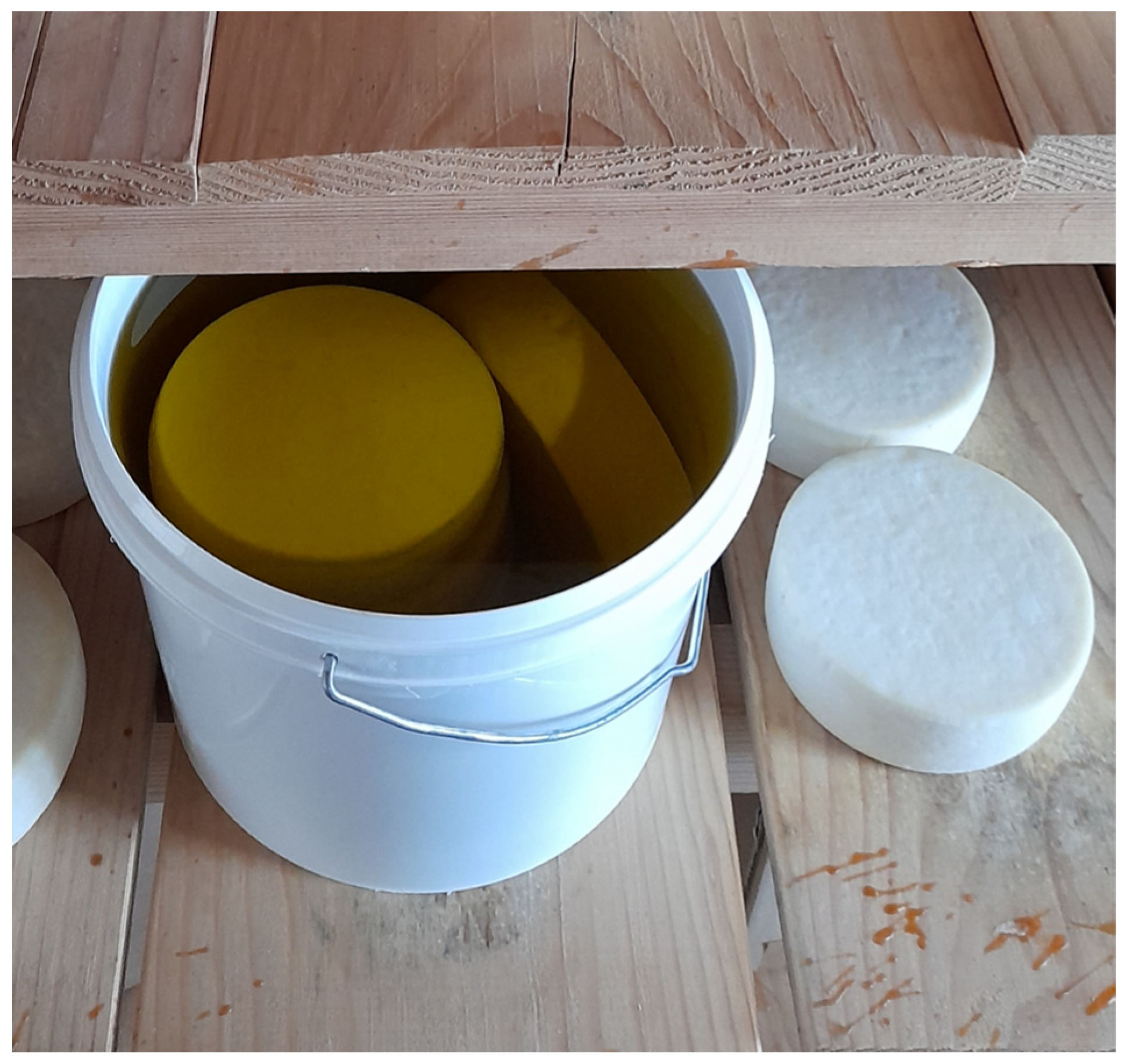
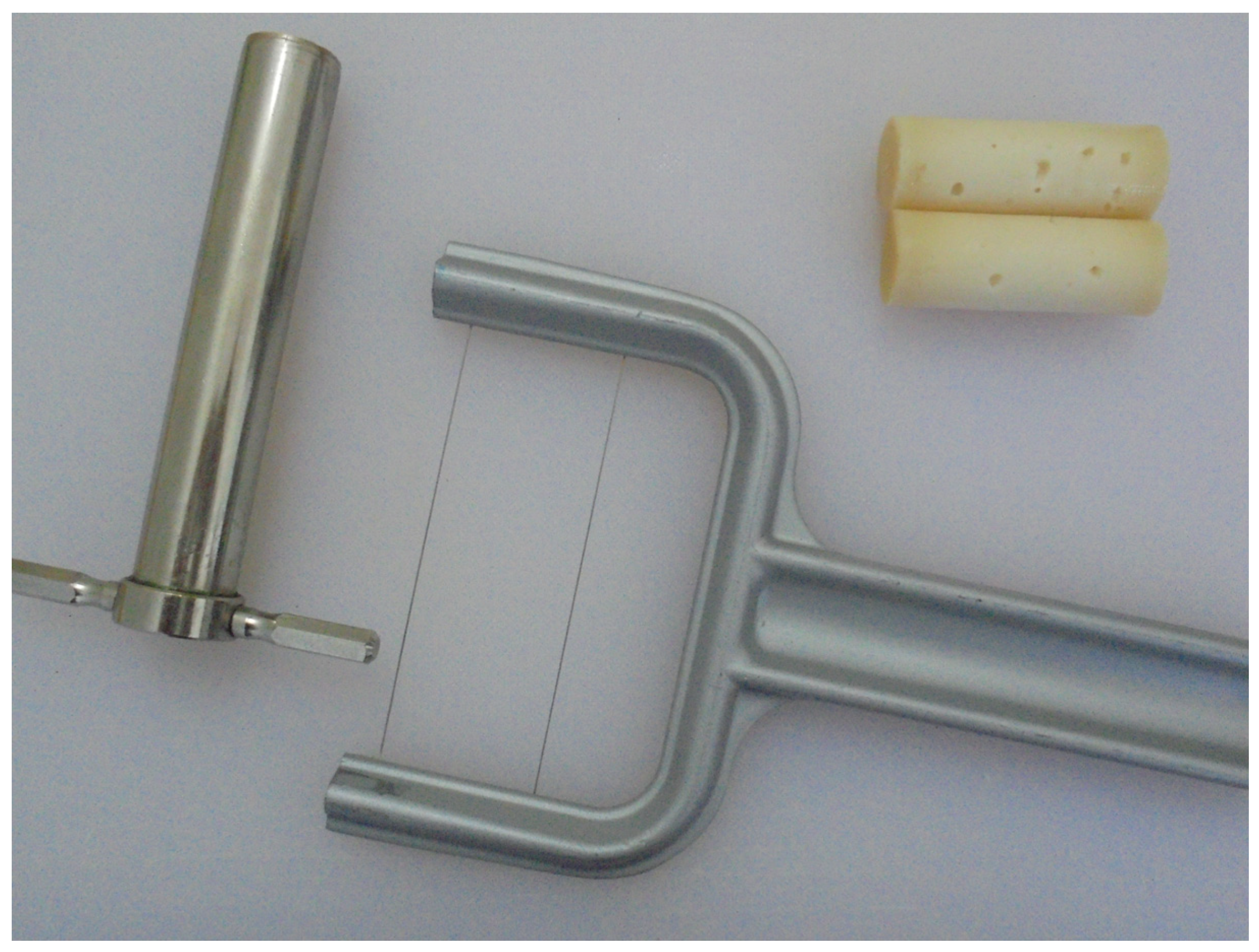

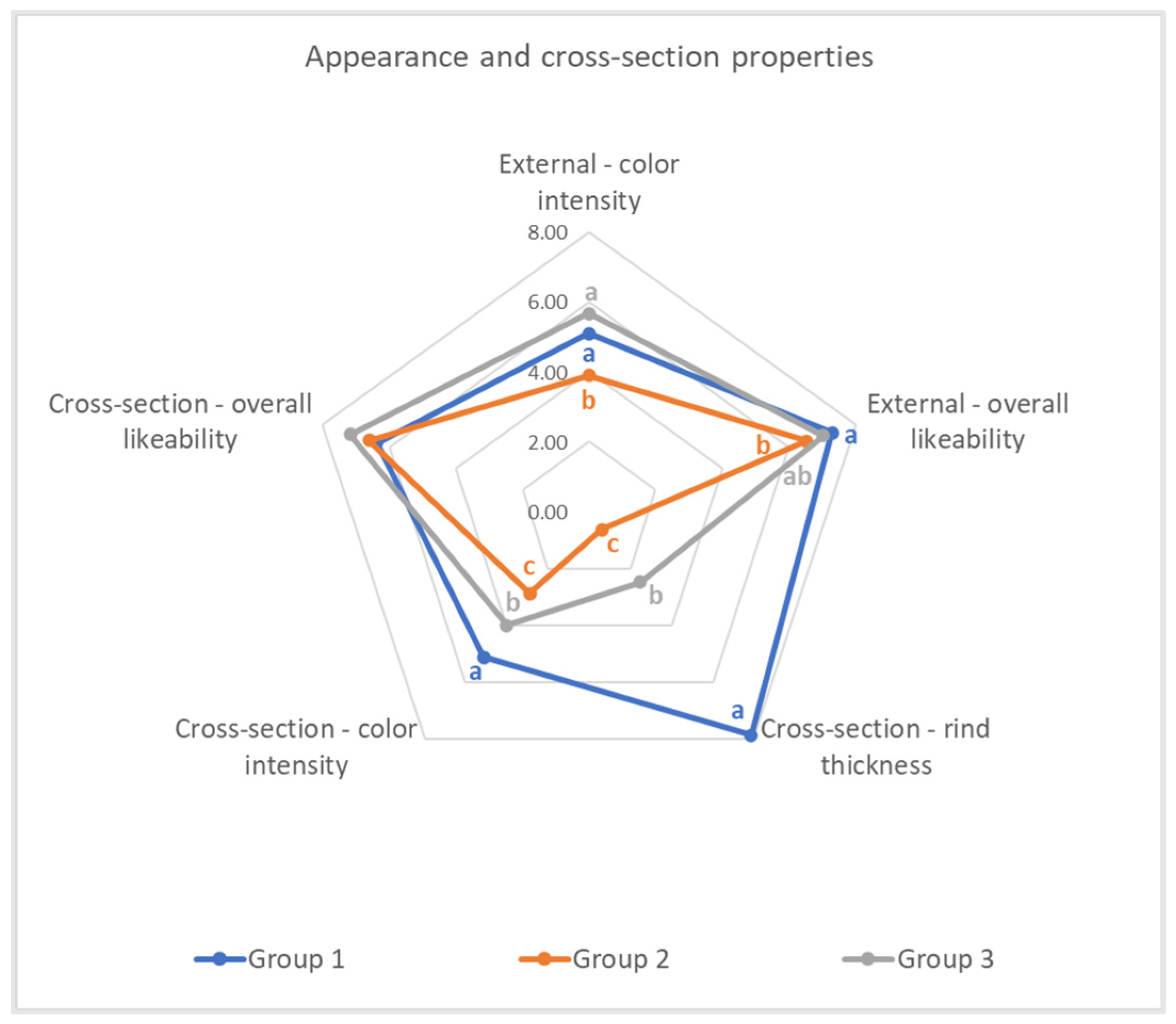
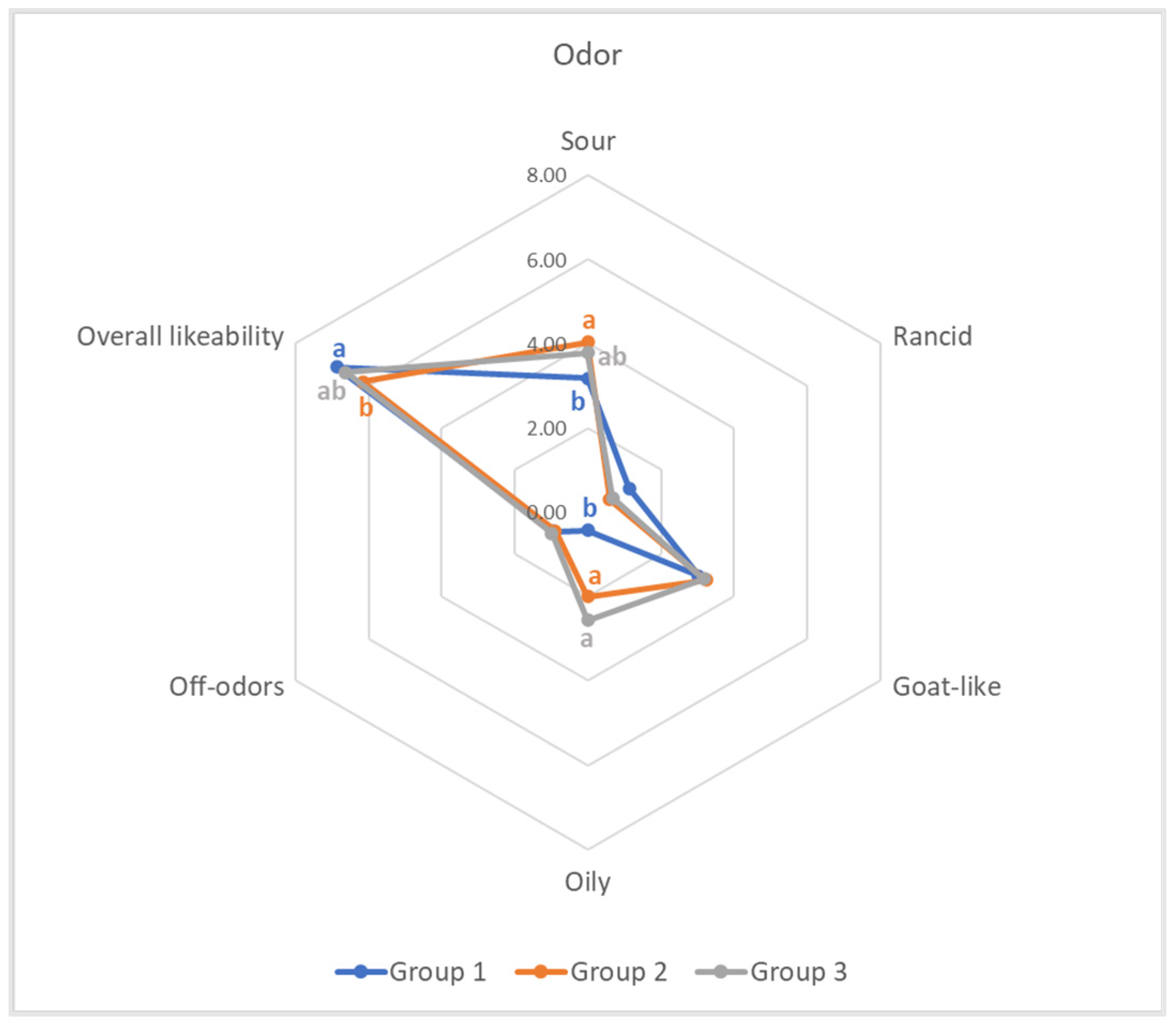
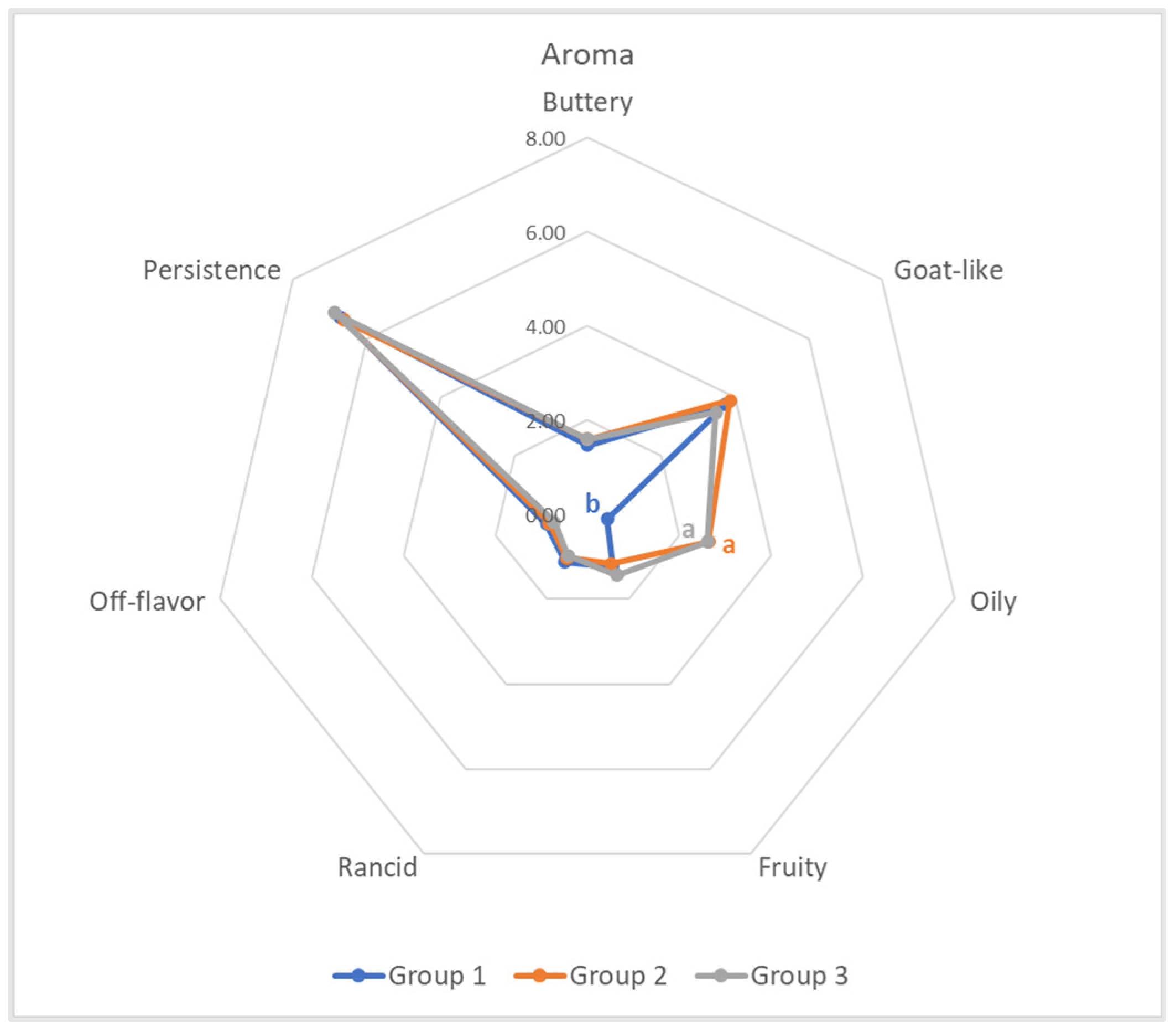
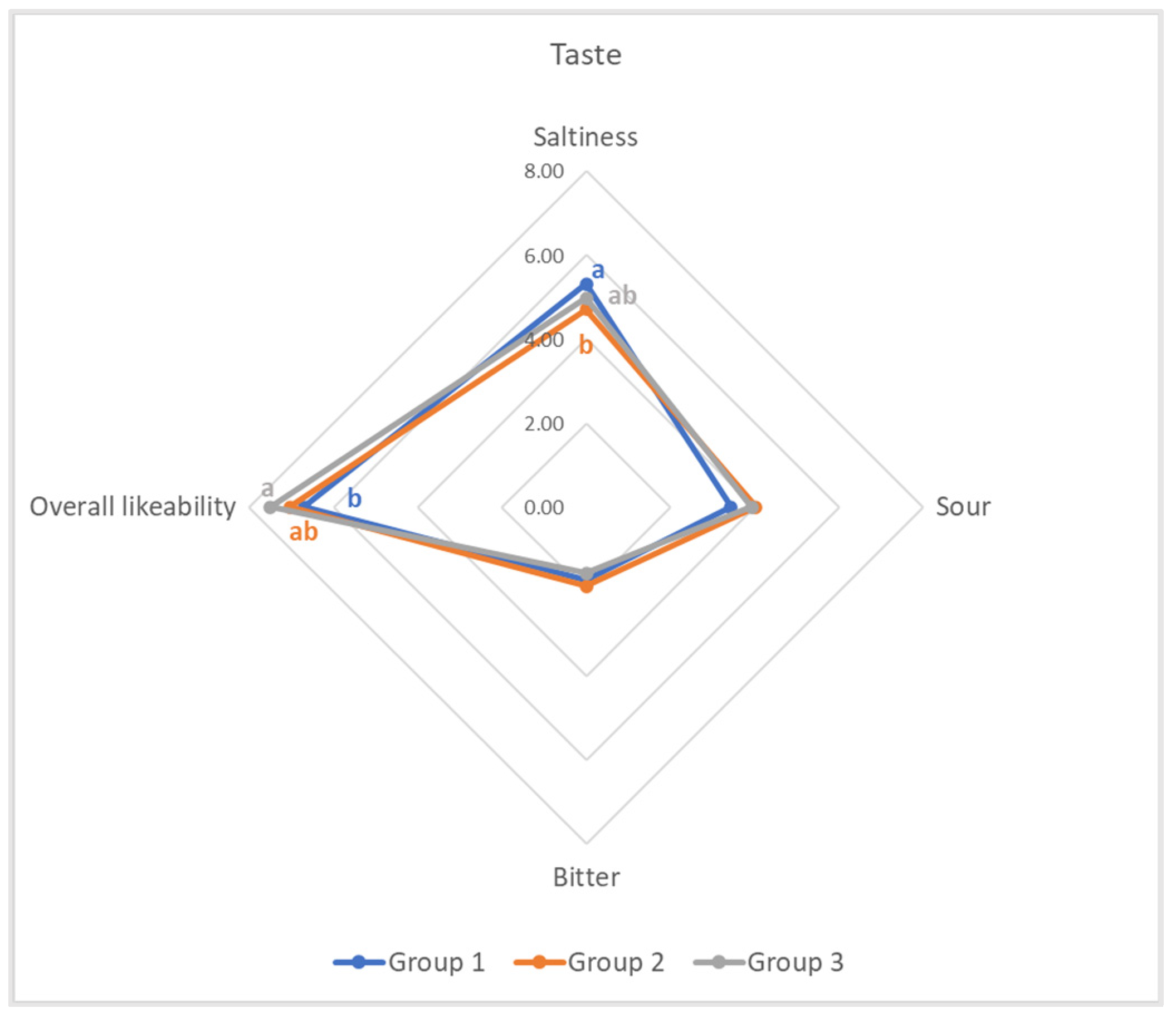
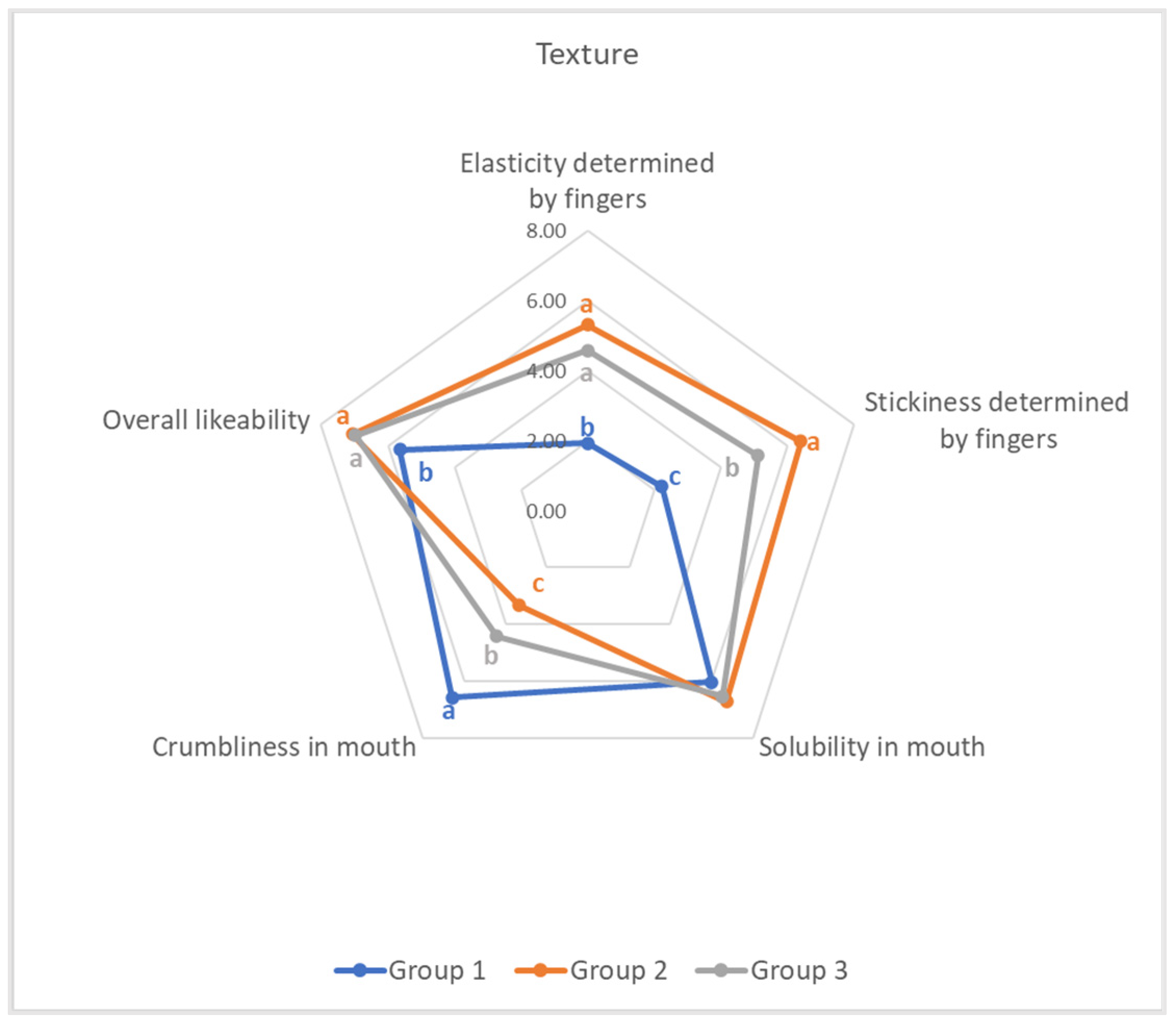
| Attribute | Descriptor | Low—0 (Not Detected/Like) | High—9 (Very Intensive/Like) |
|---|---|---|---|
| Appearance | External—color intensity | Cottage cheese | Cheddar |
| External—overall likeability | 0 | 9 | |
| Cross-section—rind thickness | <5 mm | >5 mm | |
| Cross-section—color intensity | Cottage cheese | Cheddar | |
| Cross-section—overall likeability | 0 | 9 | |
| Odor | Sour | 0 | Fermented milk |
| Rancid | 0 | Unpleasant | |
| Goat-like | 0 | Goat | |
| Oily | 0 | Oil | |
| Off-odors | 0 | Barn, basement etc. | |
| Overall likeability | 0 | 9 | |
| Texture | Elasticity determined by fingers | Parmesan | Mozzarella |
| Stickiness determined by fingers | 0 | Cheddar | |
| Solubility in mouth | Parmesan | Mozzarella | |
| Crumbliness in mouth | Mozzarella | Parmesan | |
| Overall likeability | 0 | 9 | |
| Taste | Saltiness | Mozzarella | Feta |
| Sour | 0 | Fermented milk | |
| Bitter | 0 | Arugula | |
| Overall likeability | 0 | 9 | |
| Aroma | Buttery | 0 | Butter |
| Goat-like | 0 | Goat | |
| Oily | 0 | Oil | |
| Fruity | 0 | Nuts, fruits | |
| Rancid | 0 | Overripen blue cheese | |
| Off-flavor | 0 | Barn, basement etc. | |
| Persistence | Mozzarella | Parmesan |
| Parameter | Group | Significance Level | ||
|---|---|---|---|---|
| 1 | 2 | 3 | ||
| Load at break (N) | 45.50 a ± 2.22 | 20.99 b ± 2.20 | 32.50 c ± 2.21 | ** |
| Adhesion force (N) | −0.31 a ± 0.07 | −0.86 b ± 0.06 | −0.54 ab ± 0.07 | * |
| Elasticity (mm) | 6.94 a ± 0.26 | 9.15 b ± 0.25 | 7.76 a ± 0.26 | ** |
| Texture analyzer | Load at Break | Crumbliness in Mouth | ||
| Group 1 | Group 2 | Group 3 | ||
| Group 1 | 0.801 ** | - | - | |
| Group 2 | - | 0.613 ** | - | |
| Group 3 | - | - | 0.513 * | |
| Adhesion force | Stickiness Determined by Fingers | |||
| Group 1 | Group 2 | Group 3 | ||
| Group 1 | 0.405 | - | - | |
| Group 2 | - | 0.143 | - | |
| Group 3 | - | - | 0.504 * | |
| Elasticity | Elasticity Determined by Fingers | |||
| Group 1 | Group 2 | Group 3 | ||
| Group 1 | 0.638 ** | - | - | |
| Group 2 | - | 0.612 ** | - | |
| Group 3 | - | - | 0.509 * | |
Disclaimer/Publisher’s Note: The statements, opinions and data contained in all publications are solely those of the individual author(s) and contributor(s) and not of MDPI and/or the editor(s). MDPI and/or the editor(s) disclaim responsibility for any injury to people or property resulting from any ideas, methods, instructions or products referred to in the content. |
© 2023 by the authors. Licensee MDPI, Basel, Switzerland. This article is an open access article distributed under the terms and conditions of the Creative Commons Attribution (CC BY) license (https://creativecommons.org/licenses/by/4.0/).
Share and Cite
Levak, S.; Kos, I.; Kalit, S.; Dolenčić Špehar, I.; Bendelja Ljoljić, D.; Rako, A.; Tudor Kalit, M. Sensory Profile of Semi-Hard Goat Cheese Preserved in Oil for Different Lengths of Time. Sustainability 2023, 15, 14797. https://doi.org/10.3390/su152014797
Levak S, Kos I, Kalit S, Dolenčić Špehar I, Bendelja Ljoljić D, Rako A, Tudor Kalit M. Sensory Profile of Semi-Hard Goat Cheese Preserved in Oil for Different Lengths of Time. Sustainability. 2023; 15(20):14797. https://doi.org/10.3390/su152014797
Chicago/Turabian StyleLevak, Stefani, Ivica Kos, Samir Kalit, Iva Dolenčić Špehar, Darija Bendelja Ljoljić, Ante Rako, and Milna Tudor Kalit. 2023. "Sensory Profile of Semi-Hard Goat Cheese Preserved in Oil for Different Lengths of Time" Sustainability 15, no. 20: 14797. https://doi.org/10.3390/su152014797
APA StyleLevak, S., Kos, I., Kalit, S., Dolenčić Špehar, I., Bendelja Ljoljić, D., Rako, A., & Tudor Kalit, M. (2023). Sensory Profile of Semi-Hard Goat Cheese Preserved in Oil for Different Lengths of Time. Sustainability, 15(20), 14797. https://doi.org/10.3390/su152014797









